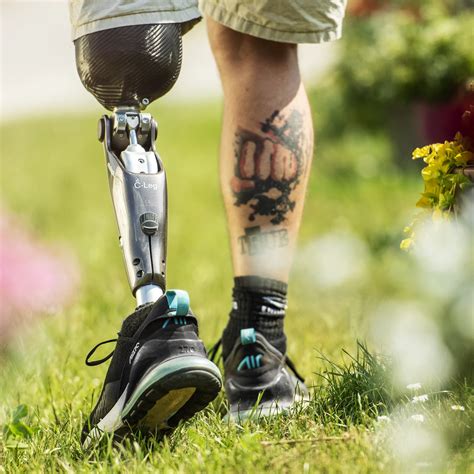The field of prosthetic devices has undergone significant transformations over the years, driven by advancements in technology, materials science, and our understanding of human physiology. Prosthetics, which are artificial devices designed to replace or support a missing or damaged body part, have evolved from simple, static structures to sophisticated, dynamic systems that can mimic the natural movement and function of human limbs. This evolution is not just about improving the quality of life for individuals with amputations but also about pushing the boundaries of what is possible in terms of human-machine interaction and rehabilitation.
Key Points
- Prosthetic devices have evolved significantly, incorporating advanced technologies such as microprocessors, sensors, and artificial intelligence.
- The development of prosthetic limbs that can be controlled by the user's thoughts, using electroencephalography (EEG) or electromyography (EMG), represents a significant advancement in the field.
- Materials science plays a crucial role in the development of prosthetics, with advancements in lightweight, durable materials improving the comfort and functionality of prosthetic devices.
- Rehabilitation and training programs are essential for individuals using prosthetic devices, helping them to adapt to their new limbs and achieve optimal functionality.
- The psychological impact of using a prosthetic device should not be underestimated, with many users experiencing a range of emotions from acceptance to frustration, highlighting the need for comprehensive support services.
Advanced Prosthetic Technologies

One of the most significant advancements in prosthetic technology is the integration of microprocessors and sensors into prosthetic limbs. These allow for real-time adjustments and feedback, enabling the prosthetic to adapt to different situations and activities. For example, a prosthetic leg can adjust its stiffness and movement pattern to accommodate walking on different terrains or climbing stairs. This level of sophistication not only improves the functionality of the prosthetic but also enhances the user’s confidence and ability to interact with their environment.
Neurocontrolled Prosthetics
A particularly exciting area of development is neurocontrolled prosthetics, where devices are controlled by the user’s thoughts or muscle signals. This is achieved through the use of electroencephalography (EEG) or electromyography (EMG) technologies, which can detect electrical activity in the brain or muscles. These signals are then translated into commands that control the prosthetic limb, allowing for a more natural and intuitive form of control. While this technology is still in its early stages, it holds immense promise for individuals with high-level amputations or those who have limited residual limb function.
| Prosthetic Type | Control Mechanism | Advantages |
|---|---|---|
| Body-Powered | Cables and harnesses | Simple, durable, and cost-effective |
| Myoelectric | Electromyography (EMG) | More natural control, less fatigue |
| Microprocessor-Controlled | Sensors and microprocessors | Adaptive, real-time adjustments for improved functionality |
| Neurocontrolled | EEG or EMG signals | Potential for intuitive, thought-controlled operation |

Rehabilitation and Training

While the technology behind prosthetic devices is crucial, equally important is the process of rehabilitation and training that individuals undergo to adapt to their new limbs. This involves not just learning how to use the prosthetic but also relearning basic movements and activities, such as walking, balance, and coordination. Rehabilitation programs are tailored to the individual’s needs and goals, taking into account the type of amputation, the individual’s overall health, and their personal objectives. The psychological aspect of this process should not be underestimated, as individuals may experience a range of emotions from grief and frustration to acceptance and empowerment.
Psychological Support
The psychological impact of losing a limb and adapting to a prosthetic device can be profound. Individuals may experience anxiety, depression, or feelings of inadequacy, highlighting the need for comprehensive support services. This includes counseling, peer support groups, and educational resources to help individuals and their families navigate the challenges of prosthetic use. By addressing the psychological and emotional aspects of prosthetic use, we can improve overall outcomes and enhance the quality of life for individuals with amputations.
What are the main types of prosthetic devices available?
+Prosthetic devices can be broadly categorized into body-powered, myoelectric, microprocessor-controlled, and neurocontrolled types, each with its unique control mechanism and advantages.
How long does it take to adapt to a prosthetic limb?
+The adaptation period can vary significantly depending on the individual, the type of prosthetic, and the level of amputation. Generally, it can take several months to a few years to achieve optimal functionality and comfort with a prosthetic device.
What role does rehabilitation play in the prosthetic process?
+Rehabilitation is a critical component of the prosthetic process, involving physical therapy, occupational therapy, and psychological support to help individuals adapt to their prosthetic devices and achieve their full potential.
In conclusion, the field of prosthetics is a vibrant and evolving area of research and development, driven by the convergence of technology, materials science, and human physiology. As we continue to push the boundaries of what is possible, it is essential to remember that the true measure of success lies not just in the technology itself, but in the positive impact it has on the lives of individuals with amputations. By combining advanced prosthetic technologies with comprehensive rehabilitation and support services, we can empower individuals to achieve their full potential and live fulfilling lives.



